The London Regiment was an infantry regiment in the British Army, part of the Territorial Force. The regiment saw distinguished service in the First World War and was disbanded in 1938, shortly before the Second World War, when most of its battalions were converted to other roles or transferred elsewhere. The lineage of some of its former battalions is continued by the current regiment of the same name.
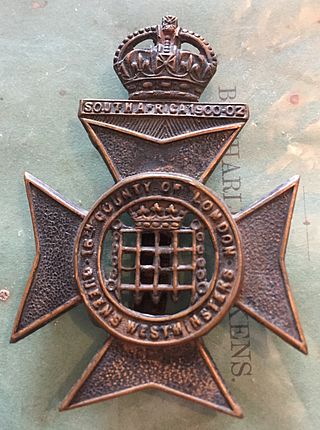
The Queen's Westminsters were an infantry regiment of the Territorial Army, part of the British Army. Originally formed from Rifle Volunteer Corps, which were established after a French invasion scare of 1859. The unit became part of the newly established London Regiment on the formation of the Territorial Force in 1908. It was subsequently amalgamated in 1921 with the Civil Service Rifles, and became a territorial Battalion of the King's Royal Rifle Corps in 1937. It ceased to exist as separate entity after it was amalgamated in 1961.

The 52nd Lowland Volunteers is a battalion in the British Army's Army Reserve or reserve force in the Scottish Lowlands, forming the 6th Battalion of the Royal Regiment of Scotland, also known as 6 SCOTS. Due to its erstwhile association with the 1st Regiment of Foot, it is the senior Reserve line infantry battalion in the British Army. It is one of two Reserve battalions in the Royal Regiment of Scotland, along with 51st Highland, a similar unit located in the Scottish Highlands.
The Denbighshire Hussars was a Welsh Yeomanry regiment of the British Army formed in 1794. It saw service in the First World War before being converted into a unit of the Royal Artillery. The lineage has been continued by 398 Squadron, Royal Logistic Corps.

The Dalmeny Street drill hall in Edinburgh, was built as a military drill hall in 1901, and between 2003 and 2010 was redeveloped as community arts and education centre under the name TheOut of the Blue Drill Hall. The drill hall is protected as a category A listed building.
The 2/1st London Brigade was a 2nd Line formation of the Territorial Force of the British Army. It was formed at the start of World War I and served in overseas garrisons in Malta and Egypt. Although it never saw action as a formation, its constituent battalions fought at Gallipoli and served against the Senussi tribesmen. The brigade was then sent to the Western Front where it was broken up to provide drafts for 1st Line units.

Fulham House is a military installation at 87 Fulham High Street, Fulham, London. It is a Grade II listed building.

Yeomanry House is a drill hall in Handel Street, Bloomsbury, London.

The Farringdon Road drill hall is a military installation at 57A Farringdon Road in Finsbury, London.
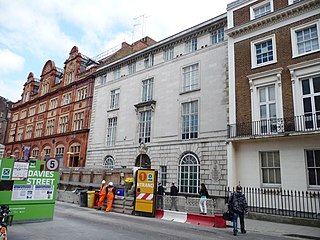
The Davies Street drill hall is a former military installation in Davies Street, London.

The Buckingham Gate drill halls were military installations at 58 and 59 Buckingham Gate, London.

Blackheath drill hall is a military installation at Blackheath in London.

St John's Hill Drill Hall is a military installation at Lavender Hill in London. The building on St John's Hill became the regimental headquarters for the London Regiment in 1993.
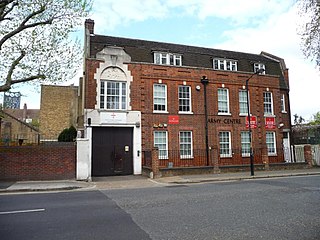
The Braganza Street drill hall is a military installation in Braganza Street, Walworth.

The Fenkle Street drill hall is a military installation in Alnwick, Northumberland. It is a Grade II* listed building.
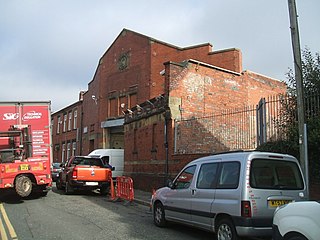
The Baron Street drill hall is a former military installation in Rochdale, England.
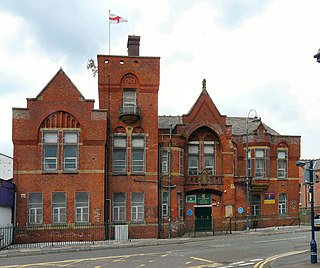
The Old Street drill hall is a former military installation in Ashton-under-Lyne, Greater Manchester, England.

The Northgate Street drill hall is a former military installation in Warwick.

2nd Battalion, London Regiment was an infantry battalion of the British Army.

The 2nd Northumberland Rifle Volunteer Corps, also referred to as the Tynemouth Rifles, was an infantry unit of Britain's part-time force, the Territorial Army. The corps was raised during the expansion of the Volunteer movement in the 1850s and then served with the Territorial Force during the First World War. It converted to an anti-aircraft role just prior to Second World War, and continued to serve until it was amalgamated in 1950.


















